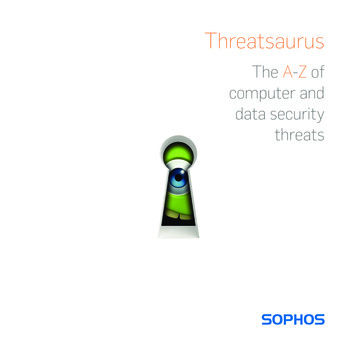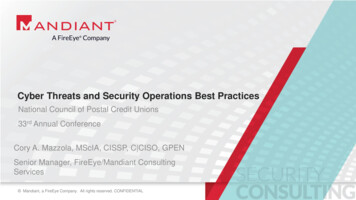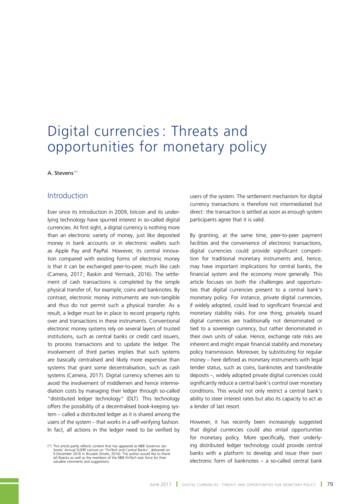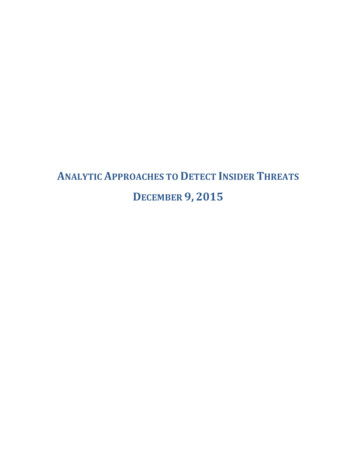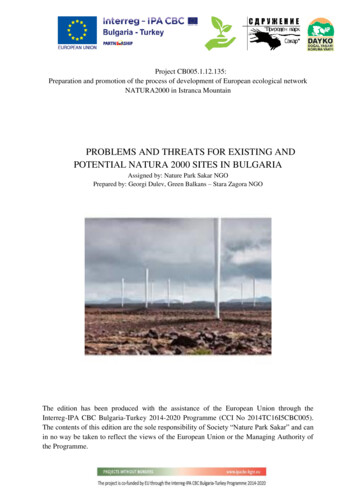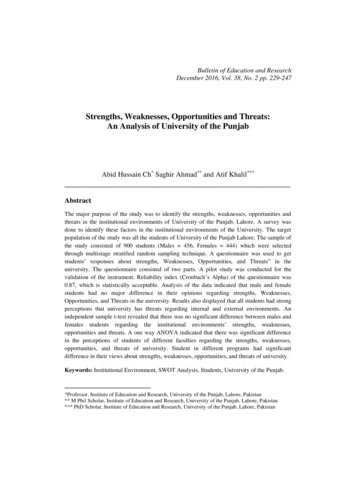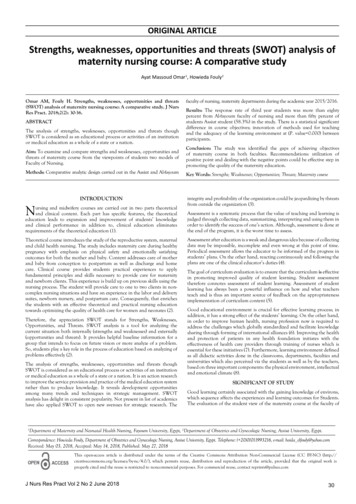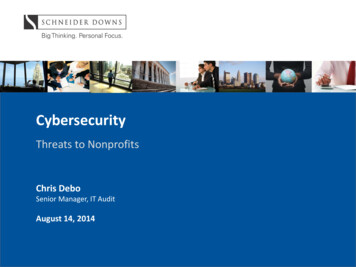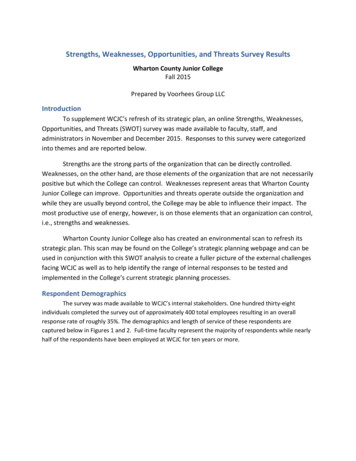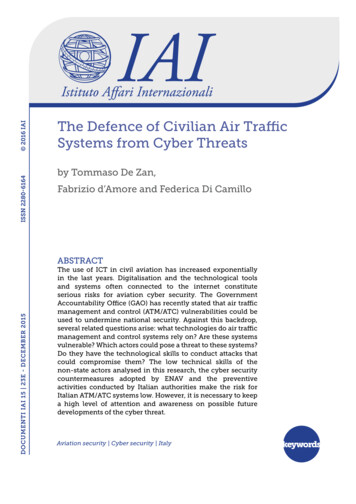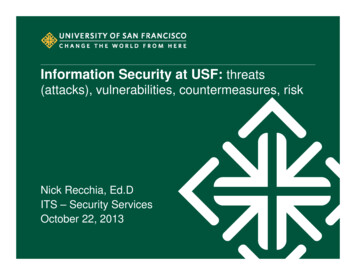
Transcription
Information Security at USF: threats(attacks), vulnerabilities, countermeasures, riskNick Recchia, Ed.DITS – Security ServicesOctober 22, 2013
OverviewPresenters:Nick RecchiaITS Security AdministratorWalter PetruskaInformation Security Officer &Director, Security Services
OverviewAgenda:1. Introduction2. Holistic approach to Information Security3. Org structure and Information Security4. Vulnerabilities & threats (attacks)5. USF network: exploring countermeasures and preventingcommon threats (attacks)6. Question/discussion
IntroductionContributes to aefficient, successful,and attractiveservice providerand nPromotes apreventative approachto IT/Infosec/businessprocess(enables business)Policies, produces,standards, guidelines(expectations)Annual SETA, sign AUP agreement,job function training(Administrative controls) Technical controls
IntroductionReference: CISSP All-in-One Exam Guide, 6th Edition, page 22
Holistic approach to Information SecurityReference: CISSP All-in-One Exam Guide, 6th Edition, page 29
Holistic approach to Information SecuritySophos AVWSUSFac/Staff vs. StuPassword resetVLAN isolation /offsite backupUSFconnectPAN NGFWOnecardReference: CISSP All-in-One Exam Guide, 6th Edition, page 29[1] fosec Policy;Secure filedestruction SOP[1]
Holistic approach to Information Security1. Vulnerability: weakness or lack of countermeasure2. Threat agent: entity that can exploit a vulnerability3. Threat: is the danger of a threat agent exploiting a vulnerability1. Risk: the probability of a threat agent exploiting a vulnerability, and theassociated impact2. Exposure: presence of a vulnerability, which exposes the organizationto a threat3. Safeguard: control that is put into place to reduce a risk; also called acountermeasureReference: CISSP All-in-One Exam Guide, 6th Edition, page 28
Holistic approach to Information SecurityFireSheepUnsecured wireless* andHTTP** useAttackerprobability & whatwill result?AICFacebook**Use VPN*WPA2Reference: CISSP All-in-One Exam Guide, 6th Edition, page 29
Holistic approach to Information SecurityReference: CISSP All-in-One Exam Guide, 6th Edition, page 67
Org structure and riskTop-down Approach- security program should be implemented in a top downapproach- initiation, support, and direction come from topmanagement: middle management staff members- make sure the people actually responsible for protectingthe company’s assets (senior management) are drivingthe program.Reference: CISSP All-in-One Exam Guide, 6th Edition, page 63
Org structure and riskBottom-up Approach- bottom-up approach refers to staff members (usually IT)try to develop a security program without getting propermanagement support and direction.- bottom-up approach is commonly less effective, not broadenough to address all security risks, and doomed to fail.Reference: CISSP All-in-One Exam Guide, 6th Edition, page 63
USF ITS (Information Technology Services)Reference: http://www.usfca.edu/its/about/staff/
SCU IS (Information Services)Reference: http://www.scu.edu/is/about/
SCU IS (Information Services)Santa Clara University: Hacker changed grades of 60 studentsBy Sean Webby and Lisa Fernandez Mercury NewsPosted: 11/14/2011Santa Clara University's academic records database was recently hacked to improve the grades of more than60 former and current undergraduate students, the university announced Monday.The university called in the FBI, which is assisting in the ongoing investigation, according to university officials.No arrests have been reported."We are taking it quite seriously," said Dennis Jacobs, Santa Clara's provost and vice president for academicaffairs. "We are reviewing and enhancing all security measures to reduce the likelihood of any intrusionin the future.“The FBI, in a written statement issued Monday, confirmed it is involved in the investigation.SCU officials said they were unaware of any other hacking incidents at the university. This one was particularlysophisticated, they said, and was only discovered when a former student came forward in August because shenoticed a grade on her transcript was better than the one on a previously printed -news/ci 19334460
SANS Institute (System Administration, Networking, and Security Institute)Organizational Information Security from Scratch - A Guarantee for Doing ItRightThe foundation for establishing the necessary protections and demonstrating therequired diligence towards protecting your organization's proprietary information canbe found in a security infrastructure that has been around in one form or anothersince the early 1990's. It provides a means to combine the technical protections(network firewalls, intrusion detection systems, traffic analyzers, etc.) with businessprocesses (risk & vulnerability testing, information security policies and procedures,etc.) into an overall.Copyright SANS InstituteReference: uarantee541?show tee-541&cat standards
Executive ManagementReference: CISSP All-in-One Exam Guide, 6th Edition, page 117
CCSF Breach 2012; Accreditation loss ion-facesclosure/Content?oid 2496026
The 8 Most Common Causes of Data Breaches(May 2013)1) Weak and Stolen Credentials, a.k.a. Passwords2) Back Doors, Application Vulnerabilities3) Malware4) Social Engineering5) Too Many Permissions6) Insider Threats7) Physical Attacks8) Improper Configuration, User shttp://www.verizonenterprise.com/DBIR/2013/
The 2013 Data Breach Investigations Report“ some organizations will be a target regardless of what they do, butmost become a target because of what they do (or don’t do).” DBIR R/2013/ ;p.13 & 48
The 2013 Data Breach Investigations BIR/2013/ ;p.48 & 49
Threat AgentsReference: CISSP All-in-One Exam Guide, 6th Edition, page 78
Threat Agent - employeeDate of occurrence: 09/2013Reference: r/Content?oid 2599830
USF ITS RelatedVulnerabilities Threats1. BYOD (ResHalls) malware can spread2. File Sharing malware can spread3. Admin Account Access computer compromise4. Immature Patch Management practices Unpatchedmachine Vulnerable to attacks5. Lack of required SETA user error / socialengineering
USF ITS Related Countermeasures1.2.3.4.5.6.Palo Alto Networks NGFWNetwork Access ControlSophos Antivirus Security and ControlQualysGuard Vulnerability ManagementCenter for Information Security (Sec. benchmarks)Security Education Training Awareness (SETA)
1) Palo Alto Networks NGFWFirewall Overview:The Palo Alto Networks firewall allows you to specify security policies based onaccurate identification of each application seeking access to your network.Unlike traditional firewalls that identify applications only by protocol and port number,this firewall uses packet inspection and a library of application signatures todistinguish between applications that have the same protocol and port, and toidentify potentially malicious applications that use non-standard ports.For example, you can define security policies for specific applications, rather than relyon a single policy for all port 80 connections. For each identified application, you canspecify a security policy to block or allow traffic based on the source and destinationzones and addresses (IPv4 and IPv6). Each security policy can also specify securityprofiles to protect against viruses, spyware, and other threats.
PA NGFW top 25 Threats: 9/27/13 to 10/04/13
PA NGFW top 25 Threats (zoom): 9/27/13 to 10/04/13
PA NGFW Top Threats #1: Sipvicious.Gen User-AgentTraffic
PA NGFW Top Threats #2: Microsoft SQL Server StackOverflow Vulnerability
PA NGFW top 25 Viruses: 9/27/13 to 10/04/13
PA NGFW top 25 Viruses (zoom): 9/27/13 to 10/04/13
PA NGFW top Viruses #1: Virus/Win32.WGeneric.jllt
PA NGFW top Viruses #2: Virus/Win32.WGeneric.jisp
PA NGFW: WildfireThe file "GTA - The Crowd (Original Mix) [GodsPlaylist].exe" is uploaded from firewallPA-5050a at 2013-10-07 17:25:12.URL: 1 7062220User: unknownApplication: web-browsingSource IP/Port:95.211.109.141/80Destination IP/Port: **********/48280Device S/N: 0009C101640This sample is malwareHere is the summary of the sample's behaviors:-Created or modified files-Modified Windows registries-Downloaded executable files-Changed security settings of Internet Explorer-Visited a malware domain-Changed the proxy settings for Internet Explorer-Modified the network connections setting for Internet Explorer-Attempted to sleep for a long period
PA NGFW: Wildfire full report
PA NGFW: Wildfire full report
PA NGFW: Wildfire full report
PA NGFW: Wildfire full report
PA NGFW: Wildfire full report
PA NGFW: Wildfire leverages VirusTotalhttps://www.virustotal.com/
2) Network Access Control – posture assessment elp/studentcomputing/nac/
Network Access Control – posture assessment /compliance
3) Sophos Antivirus Security and Control
Sophos AV: Admin dashboard10/04/13
Sophos AV: Admin dashboard 10/04/13
Sophos AV: Admin dashboard 10/04/13
Sophos AV: Admin dashboard 10/04/13Reference: eat-analyses/viruses-andspyware/Troj PDFJS-WD/detailed-analysis.aspx
Sophos AV: Admin dashboard 10/04/13
Sophos AV: Admin dashboard 10/04/13Reference: eat-analyses/viruses-andspyware/Mal Conficker-A/detailed-analysis.aspx
4) QualysGuard Vulnerability Management:Admin dashboard 10/4/13
QualysGuard Vulnerability Management: now/thenSummary of discovered Vulnerabilities (Trend)Summary of discovered Vulnerabilities (Trend)Severity 5 "Urgent" : 8 (-1)Severity 4 "Critical" : 65 (-3)Severity 3 "Serious" : 440 (-1)Severity 2 "Medium" : 1361 (-3)Severity 1 "Minimal" : 150 ( )Severity 5 "Urgent" : 100 (0,1,99,0)Severity 4 "Critical" : 195 (0,0,195,0)Severity 3 "Serious" : 1283 (7,13,1263,-6)Severity 2 "Medium" : 1585 (13,14,1558,-9)Severity 1 "Minimal" : 124 (4,0,120,-24)TotalTotal: 2024: 3287Vulnerability Trend Status:(NEW,REOPENED,ACTIVE,-CLOSED) processed forthis scan(note that TOTAL NEW REOPENED ACTIVE forthis scan, with CLOSED already fixed)
QualysGuard Vulnerability Management: now/thenDate: 09/2010Date: 09/2013Summary of discovered Vulnerabilities (Trend)Summary of discovered Vulnerabilities (Trend)Severity 5 "Urgent" : 8 (-1)Severity 4 "Critical" : 65 (-3)Severity 3 "Serious" : 440 (-1)Severity 2 "Medium" : 1361 (-3)Severity 1 "Minimal" : 150 ( )Severity 5 "Urgent" : 100 (0,1,99,0)Severity 4 "Critical" : 195 (0,0,195,0)Severity 3 "Serious" : 1283 (7,13,1263,-6)Severity 2 "Medium" : 1585 (13,14,1558,-9)Severity 1 "Minimal" : 124 (4,0,120,-24)TotalTotal: 2024: 3287Vulnerability Trend Status:(NEW,REOPENED,ACTIVE,-CLOSED) processed forthis scan(note that TOTAL NEW REOPENED ACTIVE forthis scan, with CLOSED already fixed)
5) Center for Information p/
Center for Information Security – create account
Center for Information Security – CIS-CAT
Center for Information Security – CIS-CAT
Center for Information Security – CIS-CAT
6) Security Education Training Awareness (SETA)Reference: http://www.usfca.edu/its/security/seta/
6a) SETA - PhishMeReference: http://www.usfca.edu/its/security/seta/phishme//
SETA - PhishMeReference: http://www.usfca.edu/its/security/seta/phishme//
SETA - PhishMe
SETA - PhishMe
6b) SETA – STH (Securing The Human)
SETA – STH (Securing The Human)
Summary:USF ITS Related Countermeasures1. Palo Alto Networks NGFW: IPS/malware protection NETWORK2. Network Access Control: endpoint protection (posture compliance)3. Sophos Antivirus Security and Control: system & endpoint protection4. QualysGuard Vulnerability Management: system & endpoint assessment5. Center for Information Security (Sec. benchmarks):system & endpointassessment6. Security Education Training Awareness (SETA): ongoing enduser training
Questions / Discussion
4. QualysGuard Vulnerability Management: system & endpoint assessment 5. Center for Information Security (Sec. benchmarks):system & endpoint assessment 6. Security Educ
